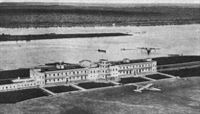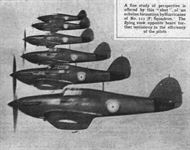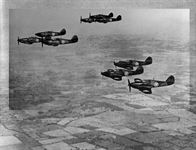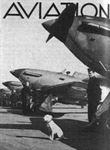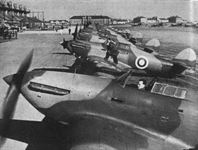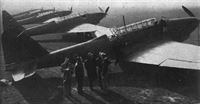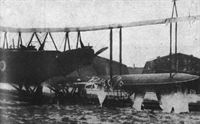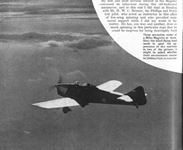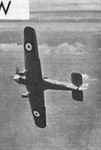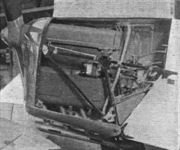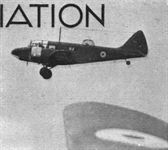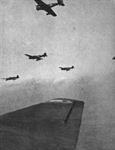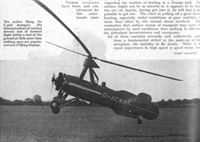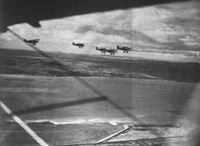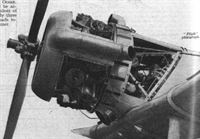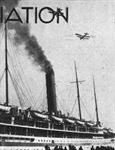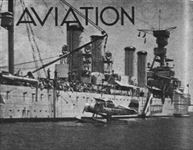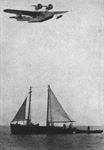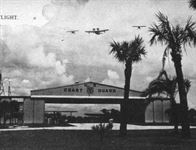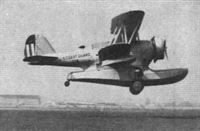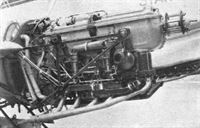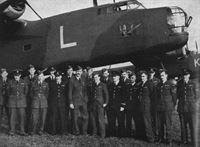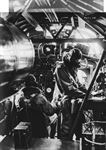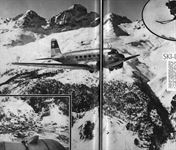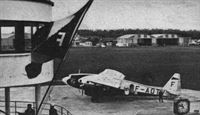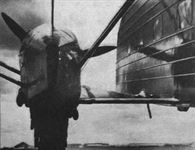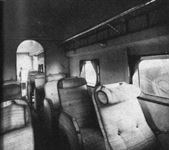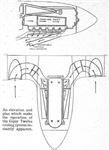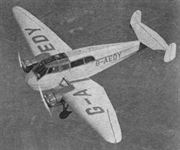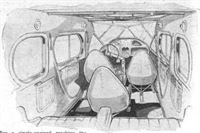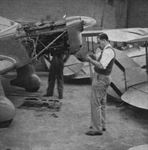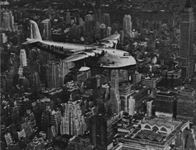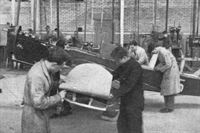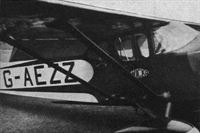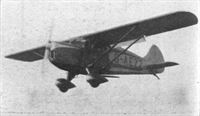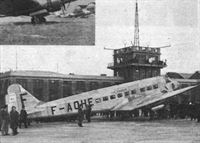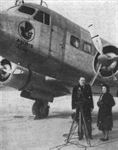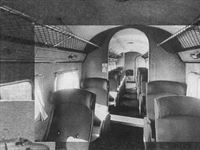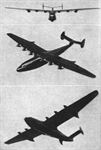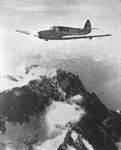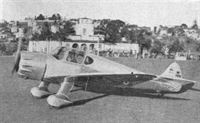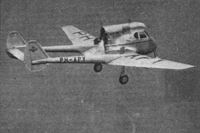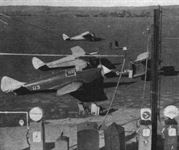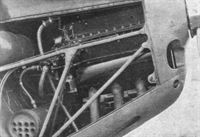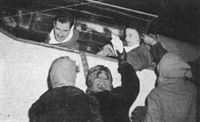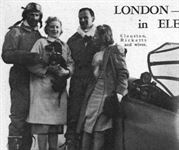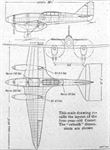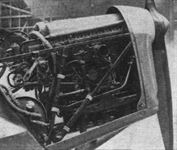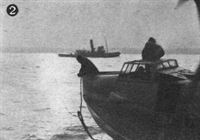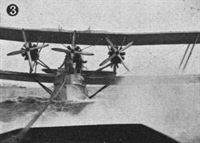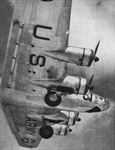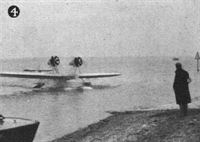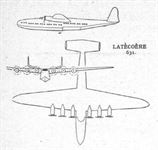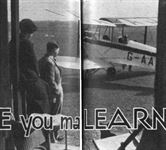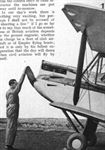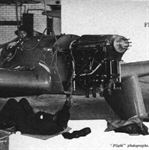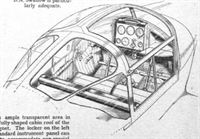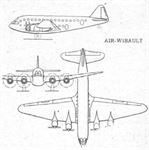Фотографии
-
Регистрационный номер: K7209 MERLIN-POWERED: An Armstrong Whitworth Whitley heavy bomber fitted experimentally with two Rolls-Royce Merlin engines. The installations are graced with all the latest advances, including ejector-type exhaust pipes. It may be that the engines are Merlin Xs, which give 1,040 h.p. at 2,500ft. and 965 h.p. at 13,250ft. “Maximum” figures are somewhat higher.
Fitted with Merlin 4s, K7209 was one of three Whitley Is converted to prototype Mk. 4s.Самолёты на фотографии: Armstrong Whitworth Whitley / A.W.38 - Великобритания - 1936
-
A FASTER WHITLEY: An example of the Armstrong Whitworth Whitley heavy bomber, now in service with Siddeley Tiger engines, has been fitted with Rolls-Royce Merlins of higher power. The new machine, as shown, has temporary fairings over nose and stem gun positions.
Самолёты на фотографии: Armstrong Whitworth Whitley / A.W.38 - Великобритания - 1936
-
OFFICIALLY READY. The terminal building and hotel of the Basra land-water airport at Margil, with a K.L.M. Douglas D.C.3 on the tarmac and an Imperial Airways Short Empire boat at her moorings in the Shatt-al-Arab River
Самолёты на фотографии: Douglas DC-3 / C-47 Skytrain/С-53 Skytrooper / Dakota - США - 1935Short Empire / S.23 - Великобритания - 1936
-
Самолёты на фотографии: Hawker Hurricane - Великобритания - 1935
-
A fine study of perspective is offered by this “shot” of an echelon formation by Hurricanes of No. 111 (F) Squadron.
Самолёты на фотографии: Hawker Hurricane - Великобритания - 1935
-
Hawker Hurricanes of No. 111 (Fighter) Squadron at Northolt. Hurricanes are fitted with Rolls-Royce Merlin engines and one squadron machine recently flew from Edinburgh to Northolt at 408 m.p.h
Самолёты на фотографии: Hawker Hurricane - Великобритания - 1935
-
CONTROLLED POWER: The world’s most formidable fighter squadron - No. 111 from Northolt - demonstrating their mastery of the Hawker Hurricane multi-gun single-seater fighter monoplanes (Rolls-Royce "Merlin") with which they have lately been equipped. The Hurricane is the fastest military aircraft in service anywhere in the world.
Самолёты на фотографии: Hawker Hurricane - Великобритания - 1935
-
Регистрационный номер: L1554, L1555, L1564 WINGS OF THE WIND: Hawker Hurricane multi-gun fighters of No. 111 (Fighter) Squadron, Northolt. The Hurricane will be a key-type in the even greater Air Force foreshadowed in Mr. Chamberlain’s speech.
Самолёты на фотографии: Hawker Hurricane - Великобритания - 1935
-
THE FASTEST SQUADRON: Pilots of No. 111 (Fighter) Squadron, Northolt, with Sqn. Ldr. Gillan, the C.O., who flew from Turnhouse to Northolt at 408.75 m.p.h., in the centre, expressing satisfaction and bearing documents.
Самолёты на фотографии: Hawker Hurricane - Великобритания - 1935
-
FIGHTING STOCK: Tigger, mascot of No. 111 (Fighter) Squadron, Northolt, has evidently ceased to be impressed by the formidable "300-pIus" Hawker Hurricanes.
Самолёты на фотографии: Hawker Hurricane - Великобритания - 1935
-
Самолёты на фотографии: Hawker Hurricane - Великобритания - 1935
-
MORE BATTLES FOR BELGIUM: Last Thursday five Fairey Battles (Rolls-Royce Merlin), the first batch of sixteen ordered by Belgium, were collected from the makers aerodrome at Heathrow, Middlesex, by Belgian Air Force pilots, making the journey to Brussels in an hour. The pilots, seen in the photograph, were Adjts. Nollet, Claert, Caryn and Geerts, and Flt. Lt. Spoelberch.
Самолёты на фотографии: Fairey Battle - Великобритания - 1936
-
Регистрационный номер: G-ADHJ, G-ADHK These extracts from the "British Movietone" slow-motion film of the separation tell the story vividly; especially do they show the steadiness of attitude in both units after separation. These pictures are not a continuous extract; they are selected from some eight feet of film.
Самолёты на фотографии: Short Mayo Composite (S.20 Mercury and S.21 Maia) - Великобритания - 1938
-
A war-time memory ot No. 214 Squadron, or, as it was then, No. 5 Wing, R.N.A.S., later divided into No. 7 and No. 14 Squadrons. The picture shows a O/400 Handley Page safely home after being “winged” by anti-aircraft fire.
Самолёты на фотографии: Handley Page H.P.12 (O/400) - Великобритания - 1917
-
The attractive view of a Miles Magister at work. Since the blind-flying hood tends to spoil the appearance of the machine in the picture, it might be asked whether these excrescences cannot be hidden!
Самолёты на фотографии: Miles Magister / M.14 - Великобритания - 1937
-
Регистрационный номер: L6919 Самолёты на фотографии: Miles Magister / M.14 - Великобритания - 1937
-
CIRRUS-MAGISTER: The first few of a batch of Cirrus Major 150 engines have been installed in Miles Magisters and encouraging results obtained. Externally, the new Cirrus combined manifold and exhaust pipe are apparent.
Самолёты на фотографии: Miles Magister / M.14 - Великобритания - 1937
-
ADVANCED TRAINER: An Airspeed Oxford (two Siddeley Cheetah X) of No. 11 F.T.S., Wittering, flying with “feet down.”
Самолёты на фотографии: Airspeed Oxford / AS.10 - Великобритания - 1937
-
Регистрационный номер: G-ADSR HOISTED: The photograph shows another stage in the flight-testing of the A.W. Ensign (four 880 h.p. Siddeley Tiger IX): she is seen with her wheels retracted. Each Lockheed undercarriage is retracted by two hydraulic jacks which have an extended length of seven feet; they are believed to be the largest yet built.
Самолёты на фотографии: Armstrong Whitworth Ensign / A.W.27 - Великобритания - 1938
-
Both the Grumman JF-2 and the Northrop Delta have the Wright Cyclone engine.
Самолёты на фотографии: Northrop Delta - США - 1933
-
Vickers Wellesley
Самолёты на фотографии: Vickers Wellesley - Великобритания - 1935
-
No. 76 (B) Squadron was the first to have the Vickers Wellesley medium bomber.
Самолёты на фотографии: Vickers Wellesley - Великобритания - 1935
-
Looking, in a way, unfamiliar with undercarriages extended - the Wellesleys taking off from Finningley.
Самолёты на фотографии: Vickers Wellesley - Великобритания - 1935
-
Pilots of No. 76 (B) Squadron. Left to right (front row): P/O. J. S. Sherwood, P/O. J. T. B. Sadler, Sgt. S. W. Jenkins, P O. W. D. Corr, P/O. J. E. Riepenhausen, P/O. J. M. Warren, Flt. Lt. Isemonger, Sqn. Ldr. L. E. J. George (Commanding Officer), F/O. L. R. Stewart, P/O. P. H. Rebbeck, P/O. F. L. Chadwick, P/O. J. N. Culverwell, P/O. C. A. Baskett. Back row: Flt. Sgt. E. G. Couch, P/O. G. K. Peacock, P/O. B. P. Jones.
Самолёты на фотографии: Vickers Wellesley - Великобритания - 1935
-
Регистрационный номер: G-ACWR Flying-officer R.A.C. Brie flying the C.30A Autogiro. His demonstrations of vertical descent and of forward flight within a foot of the ground at little more than walking pace are popular features of flying displays.
Самолёты на фотографии: Cierva/Avro C.30A / Rota - Великобритания - 1932
-
BELFAST OPENING: Hawker Hind light bombers of No. 502 (Ulster) (Bomber) Squadron in their demonstration of formation flying at the opening last Wednesday, by Mrs. Neville Chamberlain, of the Belfast Harbour Airport. The airport adjoins the Short and Harland factory, so presumably will be used for the testing of the Hereford bombers now under construction.
Самолёты на фотографии: Hawker Hind - Великобритания - 1934
-
This photograph - the first closeup to be published of the installation of the Bristol two-row sleeve-valve Hercules in its Northrop A.17 flying test-bed - shows how compactly a unit giving over 1,300 h.p. can be installed. Features to be noted are the single large exhaust outlet, the air intake scoop above the cowling, the controllable cooling gills and the mounting behind the bulkhead for the Bristol remote box for auxiliary drives.
Самолёты на фотографии: Northrop A-17 / 8A Nomad - США - 1934
-
A Swordfish and a Shark dip over the troop transport bearing R.A.F. units to eastern parts.
Самолёты на фотографии: Blackburn Shark / B-6 - Великобритания - 1933Fairey Swordfish - Великобритания - 1934
-
COURTESY CALL: A Curtiss SOC-1 observation floatplane about to be taken on board the U.S. cruiser Milwaukee at Singapore after celebrations in connection with the opening of the new dock.
Самолёты на фотографии: Curtiss SOC Seagull - США - 1934
-
Curtiss SOC-2 scout-observation floatplanes from the U.S. cruiser Louisville are seen in highly creditable formation. These machines have Handley-Page slots and slotted flaps, and are fitted with the Pratt and Whitney Wasp engine of about 550 h.p.
Самолёты на фотографии: Curtiss SOC Seagull - США - 1934
-
A Dolphin drops a hurricane warning to a fishing vessel in the Gulf of Mexico.
Самолёты на фотографии: Douglas Dolphin / RD / OA-4 - США - 1930
-
A Douglas Dolphin and a brace of Fairchild 24s at their St. Petersburg (Florida) base
Самолёты на фотографии: Douglas Dolphin / RD / OA-4 - США - 1930Fairchild C-61 Forwarder / Model 24 / Argus - США - 1932
-
A Douglas Dolphin (two P. and W. Wasps) comes to the aid of a burning fishing craft.
Самолёты на фотографии: Douglas Dolphin / RD / OA-4 - США - 1930
-
Both the Grumman JF-2 and the Northrop Delta have the Wright Cyclone engine. The Grumman is similar to a type used by the U.S. Navy.
Самолёты на фотографии: Grumman JF / J2F Duck - США - 1933
-
CITIZEN PILOTS: Cadets of Australia’s Citizen Air Force receiving armament instruction at Laverton aerodrome. They fly Ansons extensively.
Самолёты на фотографии: Avro Anson / Type 652 - Великобритания - 1935
-
Two Series I Sixes power the De Havilland Rapide. The cold intake, and inside warm air intake with flame trap, can be distinguished.
Самолёты на фотографии: De Havilland Dragon Rapide / Dominie / D.H.89 - Великобритания - 1934
-
No. 214 (B.) Squadron’s H.P. Harrows demonstrate echelon, stepped up - an unusual formation for heavy bombers.
Самолёты на фотографии: Handley Page Harrow / H.P.54 - Великобритания - 1936
-
Some pilots of No. 214 (Bomber) Squadron (left to right): P/O. J. B. Murray; Sgt. Sach; P/O. F. L. H. Eddison; Sgt. Styles; P/O. C. L. Gilbert; P/O. K. W. Kaufmann; P/O. H. W. Poultney; Sqn Ldr. H. A. Constantine; P/O. P. C. Pickard; P/O. J. M. Griffith-Jones; P/O. E. J. Carter; F/O. R. E. Dupont; P/O. H. E. Bufton; P/O. L. M. Craigie- Halkett; F/O. B. D. Sellick; P/O. R. C. Simmons; Flt. sgt. Blake: Sgt. Duffy.
Самолёты на фотографии: Handley Page Harrow / H.P.54 - Великобритания - 1936
-
Самолёты на фотографии: Handley Page Harrow / H.P.54 - Великобритания - 1936
-
A vivid impression, by Flight's photographer, of the crew of one of the Handley Page Harrow heavy bombers of No. 214 (Bomber) Squadron. The second pilot has left his seat to check navigation at the chart table; the head of the first pilot can just be seen above the fuselage cross-member. Seated on the left is the radio operator.
Самолёты на фотографии: Handley Page Harrow / H.P.54 - Великобритания - 1936
-
Регистрационный номер: HB-ISI Winter sports enthusiasts can now reach the St. Moritz playgrounds by means of Swissair’s new "on demand" fine-weather service from London to Samaden, the 5,000 ft. aerodrome adjoining the famous resort. This fine photograph shows the Douglas D.C.2 amid some of the most striking scenery of the Engadine
Самолёты на фотографии: Douglas DC-1 / DC-2 / C-32 / C-39 - США - 1933
-
A view of St. Moritz itself, taken by a member of the staff of Flight from the D.C.2 as it circled the town.
Самолёты на фотографии: Douglas DC-1 / DC-2 / C-32 / C-39 - США - 1933
-
Регистрационный номер: F-AOTV The Potez at Lyons airport.
Самолёты на фотографии: Potez Potez 62 / 65 - Франция - 1935
-
An unusual angle on the Potez 621 (two 700 h.p. Hispanos) used on the Paris-Lyons run.
Самолёты на фотографии: Potez Potez 62 / 65 - Франция - 1935
-
The two six-seater cabins of an Air France Potez 621.
Самолёты на фотографии: Potez Potez 62 / 65 - Франция - 1935
-
Регистрационный номер: OO-AVB The Belgian SA.B.C.A. 30, an unorthodox two-seater with 40 h.p. Sarolea engine.
Самолёты на фотографии: SABCA S.30 - Бельгия - 1936
-
Staggered side-by-side seating in the new two-seater Tipsy increases the effective amount of room available for the occupants. The dual control column arrangement is interesting.
Самолёты на фотографии: Tipsy B / BC - Бельгия - 1937
-
The Carden-Ford in the Chilton Minor
Самолёты на фотографии: Chilton D.W.1 - Великобритания - 1937
-
Inside the two cockpits of a typical ab initio and aerobatic trainer - the D.H. Tiger Moth.
Самолёты на фотографии: De Havilland Tiger Moth / D.H.82 - Великобритания - 1931
-
In this photograph the intake trunk from the leading edge to the cylinder banks can be seen. The picture, incidentally, shows how the whole installation of the inverted vee-twelve engine is little larger in diameter than the airscrew spinner.
Самолёты на фотографии: De Havilland Albatross / D.H.91 - Великобритания - 1937
-
An elevation and plan which make the operation of the Gipsy Twelve cooling system instantly apparent.
Самолёты на фотографии: De Havilland Albatross / D.H.91 - Великобритания - 1937
-
Регистрационный номер: G-AEDY The smaller Pobjoy-engined Monospar S.T.25.
Самолёты на фотографии: General Aircraft Monospar ST-25 Universal - Великобритания - 1935
-
The hinged panel of the Monospar Universal is designed for ambulance and freighter work, fifth seat may be "manufactured" from tne luggage tray at the rear of the cabin.
Самолёты на фотографии: General Aircraft Monospar ST-25 Universal - Великобритания - 1935
-
The high-pressure, flexible oil-pipe from pump to v.p. airscrew operating mechanism can be seen on the Series II Gipsy-Six installed in the Heston Phoenix.
Самолёты на фотографии: Heston Phoenix - Великобритания - 1935
-
For a single-engined machine the amount of space available in the Heston Phoenix is noteworthy. The seating arrangement shown is that for charter or feeder-line work.
Самолёты на фотографии: Heston Phoenix - Великобритания - 1935
-
A neat installation of the Anzani twin in the Luton Minor.
Самолёты на фотографии: Luton Minor - Великобритания - 1937
-
Регистрационный номер: G-AFCR REGAL POISE: The prototype Monarch, Mr. F. G. Mile's new offering to the private owner. One of its big selling points is likely to be the "glide control," the precise nature of which is still something of a secret.
Самолёты на фотографии: Miles Monarch / M.17 - Великобритания - 1938
-
THE LATEST MILES: The new Monarch, which may be described as a development of the Miles Whitney Straight, posed suitably in front of the Falcon Hotel at Reading Aerodrome. This machine, which has a number of interesting features, should be out and about in a week or two.
Самолёты на фотографии: Miles Monarch / M.17 - Великобритания - 1938
-
Самолёты на фотографии: Percival Mew Gull - Великобритания - 1934
-
Регистрационный номер: G-AFAV A fast four-seater - the Percival Vega Gull, shown here with a Series II Gipsy Six and v.p. airscrew.
Самолёты на фотографии: Percival Vega Gull / K.1 - Великобритания - 1935
-
Самолёты на фотографии: Percival Vega Gull / K.1 - Великобритания - 1935
-
Регистрационный номер: G-ADHM The Short Empire boat Caledonia over New York after one of her experimental Atlantic trips last year.
Самолёты на фотографии: Short Empire / S.23 - Великобритания - 1936
-
Регистрационный номер: G-ADNO Students at the De Havilland Technical school are busy modifying their T.K.2 monoplane for this year’s races. It is to have a Series II Gipsy Major; the engine shown is a dummy.
Самолёты на фотографии: De Havilland Technical School T.K.2 - Великобритания - 1935
-
Регистрационный номер: G-AEZZ [3] Самолёты на фотографии: Foster Wikner Wicko - Великобритания - 1936
-
Регистрационный номер: G-AEZZ [3] One of the “contour-changing” flaps of the Wicko, which assist considerably its already docile behaviour in the air.
Самолёты на фотографии: Foster Wikner Wicko - Великобритания - 1936
-
Регистрационный номер: G-AEZZ [3] The Wicko Monoplane, shown here making an approach with the flaps fully down
Самолёты на фотографии: Foster Wikner Wicko - Великобритания - 1936
-
In this view into the Wicko’s cabin the flap lever may be seen behind the nearest of the two control columns. Engine controls are of the “organ-stop” type.
Самолёты на фотографии: Foster Wikner Wicko - Великобритания - 1936
-
Регистрационный номер: F-AOHE Views of the Bloch 220 on the ground at Croydon respectively.
Самолёты на фотографии: Bloch MB.220 - Франция - 1936
-
M. Charvet, the Secretary-General of Air France, introduces Mme. Maryse Bastie, the well-known pilot, who christened the Bloch at Le Bourget and afterwards travelled in it over to Croydon for the first regular service on the following day.
Самолёты на фотографии: Bloch MB.220 - Франция - 1936
-
Flight deck of the early Bloch 220, probably the prototype, with three-panel windscreen.
FOR THE PARIS RUN: The control cabin of the new Marcel Bloch 220 which is shortly to be introduced on the London-Paris-Marseilles service by Air France. The radio receiver on the right, matching the blind-flying panel on the left, is an interesting feature and it will be noticed that the windscreen layout is very similar to that of the Wibault which will be replaced.Самолёты на фотографии: Bloch MB.220 - Франция - 1936
-
View aft from the front cabin of a Bloch 220.
Самолёты на фотографии: Bloch MB.220 - Франция - 1936
-
A wind-tunnel model of the French C.A.M.S. 161 trans-oceanic flying-boat (reproduced by courtesy of l'Aeronautique), some notes on which were given in Flight last week.
Самолёты на фотографии: Potez-CAMS Potez-CAMS 160 / 161 - Франция - 1938
-
One of the most efficient of modern light aircraft is the German Messerschmitt Taifun with 240 h.p Argus. Its top speed is just on 190 m.p.h. and it seats four.
Самолёты на фотографии: Messerschmitt Bf.108 Taifun - Германия - 1934
-
The Hamburger Ha 139 seaplane is all-cantilever, even to the float support. The only exception is the tail, which is strut-braced. Note the “cranked’’ wing The machine is used by the Deutsche Luft Hansa on the Atlantic service and is catapulted off the floating base ship.
Самолёты на фотографии: Blohm und Voss Ha.139 - Германия - 1936
-
British equipment figures prominently in the Dutch Koolhoven two-seat trainer
Самолёты на фотографии: Koolhoven FK-56 - Нидерланды - 1938
-
Самолёты на фотографии: Koolhoven FK-56 - Нидерланды - 1938
-
Регистрационный номер: NX18601 A CLIPPER SEES DAYLIGHT: Out of its massive “cocoon” of scaffolding, the hull of the first of six Boeing 314 trans-oceanic flying boats is now on the slipway at Seattle. The special beaching gear is eight-wheeled and weighs fifteen tons.
Самолёты на фотографии: Boeing Boeing 314 Clipper - США - 1938
-
Регистрационный номер: HB-EIL [4] THE NEW FAIRCHILD: One of the first - if not the first - private machines to land at the new St. Moritz landing ground was a Fairchild 24 brought over by Herr Kronfeld. The 1938 version of this machine, for which M. Antoine Gazda is offering concessions in this country, is a full four-seater with ample luggage accommodation.
Самолёты на фотографии: Fairchild C-61 Forwarder / Model 24 / Argus - США - 1932
-
Регистрационный номер: HB-EIL [4] A striking impression of the Fairchild "24" in action
Самолёты на фотографии: Fairchild C-61 Forwarder / Model 24 / Argus - США - 1932
-
Регистрационный номер: HB-EIL [4] Самолёты на фотографии: Fairchild C-61 Forwarder / Model 24 / Argus - США - 1932
-
Регистрационный номер: HB-EIL [4] The way in which the fuselage shape is "humped" to provide head-room may be seen in this view of the machine.
Самолёты на фотографии: Fairchild C-61 Forwarder / Model 24 / Argus - США - 1932
-
Inside the Fairchild's cabin. The general layout is arranged on lines comforting to the car owner and the dashboard scheme is worthy of note. The flap lever is in the centre.
Самолёты на фотографии: Fairchild C-61 Forwarder / Model 24 / Argus - США - 1932
-
Регистрационный номер: PJ-AIP CYCLONE-POWERED “FOURTEEN”: The first Lockheed 14 transport for the Royal Dutch Air Lines. This model has Wright Cyclone G engines (850/1,000 h.p.) which, it is estimated, should give it a top speed of over 265 m.p.h. Machines of this type will be used on K.L.M.’s West Indian services, and this particular 14 has recently been flown to Curasao by Cdr. Geisendorfler.
Самолёты на фотографии: Lockheed Super Electra 14 - США - 1937
-
Регистрационный номер: NC17372 A metal stressed skin side-by-side two-seater from the States: the Ryan S-C with Menasco engine.
Самолёты на фотографии: Ryan SC - США - 1937
-
Регистрационный номер: PH-APY, R2676 A result of close application to private-owner problems: the American Stearman-Hammond Y with Menasco engine. It was one of the first "modern" machines to have a tricycle undercarriage.
Самолёты на фотографии: Stearman-Hammond Y-1 - США - 1936
-
The B. A. Eagle, which has a reputation for exceptional cabin quietness among light aeroplanes.
Самолёты на фотографии: British Klemm BK-1 Eagle - Великобритания - 1934
-
Seen over the petrol pumps, is the sunny expanse of Lympne - part Air Ministry airport, part Service aerodrome, but primarily the home of the Cinque Ports Flying Club.
Самолёты на фотографии: Miles Whitney Straight / M.11 - Великобритания - 1936
-
There is plenty of room under the Miles Whitney Straight “bonnet” for the Villiers Hay Maya engine
Самолёты на фотографии: Miles Whitney Straight / M.11 - Великобритания - 1936
-
Two approaches to the “double-decker ” problem: The Air-Wibault (top], and the Breguet 760
Самолёты на фотографии: Breguet Br.760 Deux Ponts/Provence/Sahara - Франция - 1949Wibault Air-Wibault 1-00 - Франция - 1939
-
The high-wing Aeronca Model K does 93 h.p. on 40 h.p.
Самолёты на фотографии: Aeronca K Scout / KM Chief - США - 1937
-
The 10-passenger 150-m.p.h. Wibault 283 (1934)
Самолёты на фотографии: Wibault Wibault 280 - Франция - 1930
-
Регистрационный номер: G-ACSS [2], K5084 [2] Clouston and Ricketts in the famous Comet
Самолёты на фотографии: De Havilland Comet / D.H.88 - Великобритания - 1934
-
Регистрационный номер: G-ACSS [2], K5084 [2] Clouston, Ricketts and wives.
Самолёты на фотографии: De Havilland Comet / D.H.88 - Великобритания - 1934
-
This scale drawing recalls the layout of the four-year-old Comet. The “rebuilt” dimensions are shown
Самолёты на фотографии: De Havilland Comet / D.H.88 - Великобритания - 1934
-
The De Havilland Gipsy Major I, here seen in a Leopard Moth, runs for 1,000 hours between overhauls.
Самолёты на фотографии: De Havilland Leopard Moth / D.H.85 - Великобритания - 1933
-
Самолёты на фотографии: De Havilland Leopard Moth / D.H.85 - Великобритания - 1933
-
Mooring practice from the nose of the Short Calcutta, used for advanced instruction.
Самолёты на фотографии: Short Calcutta / Rangoon / S.8 - Великобритания - 1928
-
“Taking in tow” is an art in itself.
Самолёты на фотографии: Short Calcutta / Rangoon / S.8 - Великобритания - 1928
-
The view from the clubhouse, opened last summer, of the Thanet Aero Club, Ramsgate.
Самолёты на фотографии: Short Scion / S.16 - Великобритания - 1933
-
ONE of the U.S. Army's imposing Boeing B-17 heavy bombers caught by the camera during a landing approach with flaps down. Though various fantastic figures have been advanced by imaginative newspapermen for the speed of this type, it is probable that the maximum is in the region of 230 m.p.h. The engines are four Wright Cyclone G radials rated at 850 h.p. each and giving over 1,000 h.p. for take-off.
Самолёты на фотографии: Boeing B-17 Flying Fortress - США - 1935
-
The Saro Cutty Sark amphibian used for initial training in flying-boat work.
Самолёты на фотографии: Saunders-Roe Cutty Sark / A.17 - Великобритания - 1929
-
Регистрационный номер: G-AFCG A scaled-down trainer biplane - the Currie Wot.
Самолёты на фотографии: Currie Wot - Великобритания - 1937
-
Latecoere 631
Самолёты на фотографии: Latecoere Late 631 - Франция - 1942
-
A privately owned Kirby Kite sailplane at the London Gliding Club’s site at Dunstable. Note the gull wing, tapered and washed-out tips, and oval fuselage.
Самолёты на фотографии: Slingsby T.6/T.23 Kirby Kite - Великобритания - 1935
-
A machine of distinctly unusual design - the Shapley Kittiwake.
Самолёты на фотографии: Shapley Kittiwake - Великобритания - 1937
-
S.E.200
Самолёты на фотографии: Sud-Est SE.200 - Франция - 1943
-
The windscreening of the B.A. Swallow is particularly adequate.
Самолёты на фотографии: British Klemm L.25 Swallow - Великобритания - 1933
-
Регистрационный номер: G-AFDN Taylorcraft A
Самолёты на фотографии: Taylorcraft A / B / C / F-19 / F-21 / F-22 - США - 1937
-
Самолёты на фотографии: De Havilland Gipsy Moth / Moth X - Великобритания - 1928
-
The Misses Mabel and Sheila Glass, whose sporting and sportsmanlike participation in races and other events, almost from the time they took their “A” licences, has earned general admiration.
Самолёты на фотографии: De Havilland Gipsy Moth / Moth X - Великобритания - 1928
-
Самолёты на фотографии: De Havilland Gipsy Moth / Moth X - Великобритания - 1928
-
A Grunau Baby sailplane climbing steeply with the aid of the London Club’s winch. The wind is too far north for slopesoaring, but the clouds are evidence of plenty of thermal lift.
Самолёты на фотографии: Schneider Grunau Baby - Германия - 1931
-
Data for the projected U.S. Consolidated oceanic flying boat are: top speed 226 m.p.h. at 10,000 ft.; range with 10,000 lb. payload, 6,000 miles; take-off time in still air 1 min. 7 sec.; gross weight 110,000 lb.; span 18s ft.; passengers, 54; crew, 10.
Самолёты на фотографии: Consolidated Lindbergh Specification - США - 1937
-
Самолёты на фотографии: Miles Sparrowhawk / M.5 - Великобритания - 1935
-
Регистрационный номер: G-AEMA There is ample transparent area in the carefully shaped cabin roof of the C.W. Cygnet. The locker on the left of the standard instrument panel can be used to accommodate any special blind flying instrument panel.
Самолёты на фотографии: C.W. Aircraft Cygnet - Великобритания - 1937
-
Air-Wibault
Самолёты на фотографии: Wibault Air-Wibault 1-00 - Франция - 1939
-
The Seversky Super-Clipper with floats retracted - a model.
Самолёты на фотографии: Seversky Super Clipper - США - 1938
Статьи
- Flight
- Flight Advertisements


